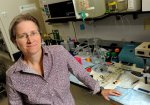Colliding Ribosomes Function as a Sentinel for Cellular Distress
Marshall W. Nirenberg Lecture | to

Rachel Green, Ph.D.
Bloomberg Distinguished Professor
John Hopkins School of Medicine
Dr. Green is a Bloomberg Distinguished Professor of molecular biology and genetics at the Johns Hopkins University School of Medicine. She also has been a Howard Hughes Medical Institute investigator since 2000. Her research on ribosome structure and function in bacterial, yeast, and human cells has revealed fundamental mechanisms of protein synthesis.Rachel Green began her scientific career majoring in chemistry as an undergraduate at the University of Michigan. Her doctoral work was performed at Harvard in the laboratory of Jack Szostak where she studied RNA enzymes and developed methodologies for evolving RNAs in vitro. She came to the JHU School of Medicine in 1998 following post-doctoral work in Harry Noller’s lab at UC Santa Cruz where she began her work on ribosomes. Her laboratory is interested in deciphering the molecular mechanisms that are at the heart of protein synthesis and its regulation across biology. This focus allows her to still think about the earliest evolutionary steps that led to life on earth, but in a system where biological questions drive the experiments. Her laboratory uses both biochemical and genomic approaches to get at these questions in bacterial and eukaryotic system.
Summary
For this talk, Dr. Green will describe her laboratory’s recent efforts to define how ribosome elongation distress is connected to cellular signaling pathways involved in cell fate determination. She will discuss how colliding ribosomes are central to this activation, and she will elucidate how a combination of approaches — from genetics, to biochemistry, to structural biology, to genomics — can reveal such insights.
This page was last updated on Thursday, May 19, 2022